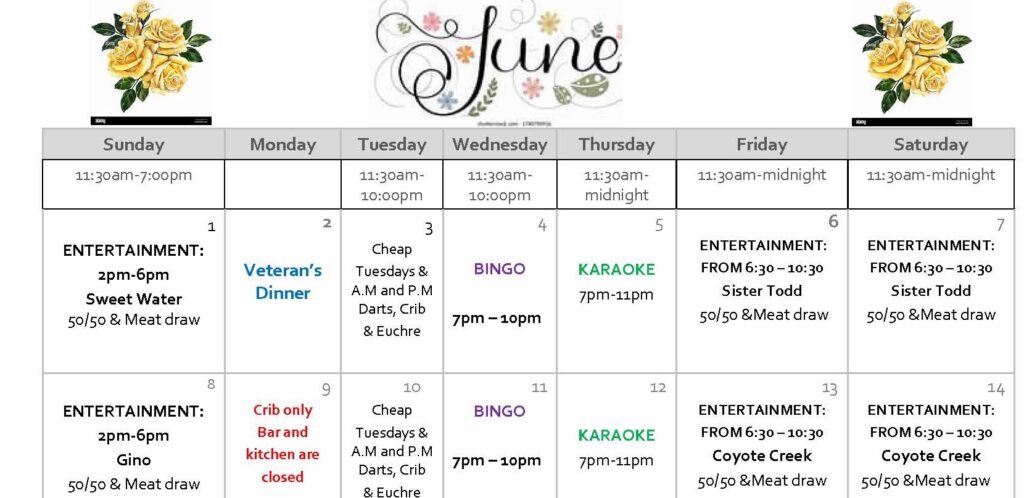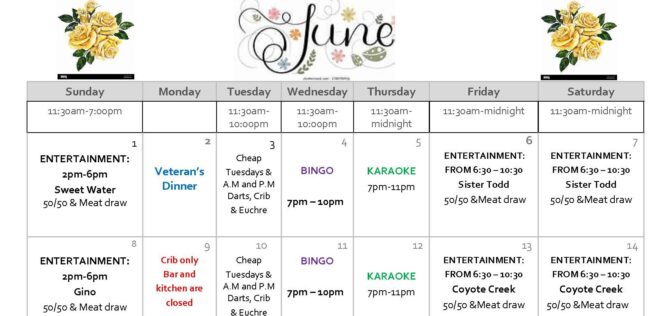Line Dance Lesson

Remember, you need to be a Legion member or signed in by a member to attend our events.

Remember, you need to be a Legion member or signed in by a member to attend our events.

Canadians took part in many hard struggles to help the Allies to victory during the Second World War. D-Day and the Battle of Normandy was one of the best-known chapters of the entire conflict and our service members would play an important role in this pivotal campaign.
Destroyers and supporting craft of the Royal Canadian Navy shelled German positions onshore and cleared sea mines in the approaches to the French beaches. Many Royal Canadian Air Force planes were among the some 4,000 Allied bombers and 3,700 fighters / fighter bombers that relentlessly struck at shoreline defences, inland targets and enemy squadrons that day.
More than 450 members of the 1st Canadian Parachute Battalion jumped inland before dawn on June 6 and were the first of our soldiers to engage the enemy on D-Day. A few hours later, some 14,000 Canadian troops from the 3rd Canadian Infantry Division and the 2nd Canadian Armoured Brigade—composed of military units from coast to coast—would begin to come ashore at Juno Beach. Their mission was to brave heavy fire to establish a foothold along an eight-kilometre stretch of coastline fronting the villages of Saint-Aubin-sur-Mer, Bernières-sur-Mer, Courseulles-sur-Mer, and Graye-sur-Mer. Our soldiers would then push inland towards the city of Caen, an important communications and transport centre.
Victory in the Battle of Normandy came at a terrible cost. The Canadians suffered the highest casualties of any divisions in the British Army Group during the campaign. Some 359 Canadian soldiers were killed on D-Day alone, and a total of more than 5,000 of our men would die during the two-and-a-half-months of fighting in Normandy. Most of these fallen heroes lie buried in France in the beautiful Bény-sur-Mer Canadian War Cemetery and the Bretteville-sur-Laize Canadian War Cemetery. Over 13,000 more of our soldiers were wounded in Normandy, with many suffering injuries to body and mind that they would carry for the rest of their lives.
Canada’s impressive efforts in the Second World War remain a point of great national pride, even many decades later. The brave Canadians who came ashore on D-Day and saw action in the Battle of Normandy were among the more than one million men and women from our country who served in the cause of peace and freedom during the conflict. Sadly, over 45,000 of them would lose their lives.
Read the full account at Veterans Canada
Image credits: Library and Archives Canada



The Ridge, Pitt Meadows, Katzie, Community Response Network is hosting a World Elder Abuse Awareness Breakfast at our Legion on June 14th from 08:30 to 09:30 am.
Registration is recommended and can be completed on Eventbrite. Follow the link.
https://tinyurl.com/bdem7v7m
 We recently received a message from Sharon Lefroy. Sharon is the niece of Flt Lt Keith Lefroy who was killed in action in November 1943 over the Netherlands.
We recently received a message from Sharon Lefroy. Sharon is the niece of Flt Lt Keith Lefroy who was killed in action in November 1943 over the Netherlands.
Although from Ingersoll ON, Sharon is keen to share the story of her Uncle and try to reach any surviving relatives. We’re proud to be able to help Sharon with their quest.
On 18 Sept 1941, Keith Lefroy was posted overseas and reported to the #3 Personnel Reception Centre (PRC) at Bournemouth, UK on 24 Oct 1941. This centre determined where aircrew would be assigned based on their qualifications and the needs of the RAF at any given time for fighter, bomber, maritime patrol or training positions.
The need for aerial gunners in the expanding Bomber Command resulted in a posting for him as a target towing pilot at #8 Aerial Gunnery School (AGS) stationed at Evanston, near Inverness Scotland on 16 Nov 1941.
The gunnery School used single engine Westland Lysander aircraft towing a cloth banner which became a target for air gunner trainees firing from the gun turret of another aircraft. Keith flew the Lysander for a total of 208 hours while at this school and then later qualified to fly the twin engined Blackburn Botha used to carry the gunnery trainees on these aerial exercises. He flew this aircraft for a total of 582 hours until he transferred out from the Gunnery School in April 1943.
 This is where Sharon’s article in the Ottawa Citizen takes up Ft Lt Lefroy’s story
This is where Sharon’s article in the Ottawa Citizen takes up Ft Lt Lefroy’s story
“It was dusk when 24-year-old Flight-Lt. Keith Lefroy and his six-member Pathfinder crew boarded the Lancaster at Gransden Lodge. It was Nov. 23, 1943, and the Second World War had been raging for four years. The Allied Forces were conducting a strategic bombing campaign aimed at crippling the German war machine.”
Read the full story here:
https://ottawacitizen.com/opinion/tulips-war-ve-day
Photos: Courtesy of Sharon Lefroy
 We recently received a message from Sharon Lefroy. Sharon is the niece of Flt Lt Keith Lefroy who was killed in action in November 1943 over the Netherlands.
We recently received a message from Sharon Lefroy. Sharon is the niece of Flt Lt Keith Lefroy who was killed in action in November 1943 over the Netherlands.
Although from Ingersoll ON, Sharon is keen to share the story of her Uncle and try to reach any surviving relatives. We’re proud to be able to help Sharon with their quest.
On 18 Sept 1941, Keith Lefroy was posted overseas and reported to the #3 Personnel Reception Centre (PRC) at Bournemouth, UK on 24 Oct 1941. This centre determined where aircrew would be assigned based on their qualifications and the needs of the RAF at any given time for fighter, bomber, maritime patrol or training positions.
The need for aerial gunners in the expanding Bomber Command resulted in a posting for him as a target towing pilot at #8 Aerial Gunnery School (AGS) stationed at Evanston, near Inverness Scotland on 16 Nov 1941.
The gunnery School used single engine Westland Lysander aircraft towing a cloth banner which became a target for air gunner trainees firing from the gun turret of another aircraft. Keith flew the Lysander for a total of 208 hours while at this school and then later qualified to fly the twin engined Blackburn Botha used to carry the gunnery trainees on these aerial exercises. He flew this aircraft for a total of 582 hours until he transferred out from the Gunnery School in April 1943.
 This is where Sharon’s article in the Ottawa Citizen takes up Ft Lt Lefroy’s story
This is where Sharon’s article in the Ottawa Citizen takes up Ft Lt Lefroy’s story
“It was dusk when 24-year-old Flight-Lt. Keith Lefroy and his six-member Pathfinder crew boarded the Lancaster at Gransden Lodge. It was Nov. 23, 1943, and the Second World War had been raging for four years. The Allied Forces were conducting a strategic bombing campaign aimed at crippling the German war machine.”
Read the full story here:
https://ottawacitizen.com/opinion/tulips-war-ve-day
Photos: Courtesy of Sharon Lefroy







“The history of the Army in Canada is as long as the history of the country itself, and forms a larger part of it than many Canadians realize. The Canadian soldier of today is the heir of a very old and a very proud tradition, and a tradition peculiarly his own. The Canadian Army shares many historical experiences with other forces - particularly the British Army - but some of those that helped to shape it are uniquely Canadian and are shared with nobody.”
From the Development of the Canadian Army - The First Two Centuries: The Old Militia by Col C.P. STACEY, O.C., O.B.E., C.D.
The Militia Act of 1855 was an Act passed by the Parliament of the Province of Canada that permitted the formation of an "Active Militia", which was later subdivided into the Permanent Active Militia and the Non-Permanent Active Militia, and divided the province into 18 military districts.
Assisted by volunteer staff officers, each district was commanded by a colonel, while the entire operation was led by Colonel Étienne-Paschal Taché. Trained at the expense of taxpayers, the volunteers were armed, equipped and paid 5 shillings a day for 10 days of training a year (20 days for those in the artillery), with captains being paid 10 shillings 6 pence a day, however, the men had to provide their own uniforms. Initially set at 5,000 men, the Act's popularity forced the government to double its size to 10,000 men by 1856.
By 1858, enthusiasm waned when economic depression occupied the minds of Canadians. In 1860, military spirit was revived by the royal visit of the Prince of Wales. Canadians, Nova Scotians, and New Brunswickers launched their own volunteer units. These companies began to form into battalions that gradually eclipsed the Sedentary Militia. In 1864, the Sedentary Militia was re-styled as the "Non-Service Militia", and in 1869, its battalions were reduced to the "Reserve Militia" of each county. The Reserve Militia was last enrolled in 1873 (but never called out), deferred thereafter, and the theory that every able-bodied man was liable for service was finally abolished in 1950.

8 May 1945 – VE Day (Victory in Europe Day) – was one that remained in the memory of all those who witnessed it. It meant an end to nearly six years of a war that had cost the lives of millions; had destroyed homes, families, and cities; and had brought huge suffering and privations to the populations of entire countries.
Millions of people rejoiced in the news that Germany had surrendered, relieved that the intense strain of total war was finally over. In towns and cities across the world, people marked the victory with street parties, dancing and singing.
But it was not the end of the conflict, nor was it an end to the impact the war had on people. The war against Japan did not end until August 1945, and the political, social and economic repercussions of the Second World War were felt long after Germany and Japan surrendered.
With Berlin surrounded, Adolf Hitler committed suicide on 30 April 1945. His named successor was Grand Admiral Karl Dönitz. During his brief spell as Germany’s president, Dönitz negotiated an end to the war with the Allies – whilst seeking to save as many Germans as possible from falling into Soviet hands.
A German delegation arrived at the headquarters of British Field Marshal Bernard Montgomery at Lüneburg Heath, east of Hamburg, on 4 May. There, Montgomery accepted the unconditional surrender of German forces in the Netherlands, northwest Germany and Denmark. On 7 May, at his headquarters in Reims, France, Supreme Allied Commander General Eisenhower accepted the unconditional surrender of all German forces. The document of surrender was signed on behalf of Germany by General Alfred Jodl and came into effect the following day.
Soviet leader Josef Stalin wanted his own ceremony. At Berlin on 8 May, therefore, a further document was signed – this time by German Field Marshal William Keitel. Dönitz’s plan was partially successful and millions of German soldiers surrendered to Allied forces, thereby escaping Soviet capture.
The news of Germany’s surrender was not surprising. It had been anticipated for some time and people across Britain were on standby to start celebrating the end of the war.
The announcement that the war had ended in Europe was broadcast to the British people over the radio late in the day on 7 May. The BBC interrupted its scheduled programming with a news flash announcing that Victory in Europe Day would be a national holiday, to take place the following day. Newspapers ran the headlines as soon as they could, and special editions were printed to carry the long-awaited announcement. The news that the war was over in Europe soon spread like wildfire across the world.
The news that the war was over in Europe quickly spread around the world, and people of the British Empire and the Allied countries wanted to celebrate the defeat of Nazi Germany.
In the United States of America, the victory was tempered with the recent death of President Roosevelt, who had led his country through the war years. His successor, Harry S. Truman, dedicated the day to Roosevelt and ordered that flags be kept at half-mast – as part of the 30-day mourning period. Despite this, there were still scenes of great rejoicing in America: in New York, 15,000 police were mobilised to control the huge crowds that had massed in Times Square.
In Australia, the celebrations were also tinged with a sombre mood. The war in the Far East and Pacific was still being fought, and many Australians were serving overseas. But there were scenes of rejoicing in many cities, and services were held in churches around the country to give thanks for the war ending in Europe.
In Paris, huge numbers of people flocked to the centre of the city to celebrate. An eyewitness recalled: ‘On the Champs Elysees they were singing 'It's a Long Way to Tipperary,'…in the Place de la Concorde to the Arc de Triomphe in the Place de l'Etoile, there was hardly any place to breathe and no place at all to move.’
The charged atmosphere and large crowds could lead to unrest. In Halifax, Canada, riots broke out among the large concentration of military personnel stationed there. Thousands of soldiers, sailors and civilians looted liquor stores – which had been closed for the VE Day holiday – and the resulting riots and vandalism resulted in several deaths.
Source: Imperial War Museum










